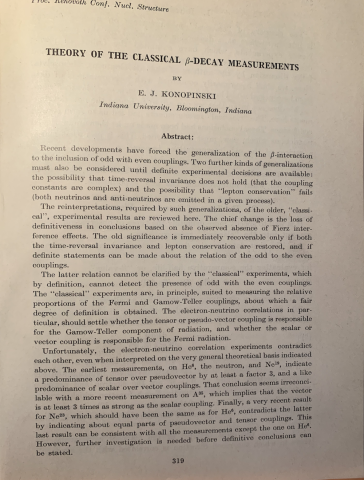Theory of the Classical Beta-Decay Measurements

Recent developments have forced the generalization of the beta interaction to the inclusion of odd with even couplings. Two further kinds of generalizations must also be considered until definite experimental decision are available: the possibility that time-reversal invariance does not hold (that the coupling constants are complex) and the possibility that “lepton conservation” fails (both neutrinos and anti-neutrinos are emitted in a given process).The reinterpretations, required by such generalizations, of the older, “classical,” experimental results are reviewed here.
The chief change is the loss of definitiveness in conclusions based on the observed absence of Fiery interference effects. The old significance is immediately recoverable only if both the time-reversal invariance and lepton conservation are restored, and if definite statements can be made about the relation of the odd to the even couplings.
The latter relation cannot be clarified by the “classical” experiments, which by definition, cannot detect the presence of odd with the even coupling. The “classical” experiments are, in principle, suited to measuring the relative proportions of the Fermi and Gamow-Teller couplings, about which a fair degree of definition is obtained. The electron-neutrino correlations in particular, should settle whether the tensor or pseudo-vector coupling is responsible for the Gamow-Teller component of radiation, and whether the scalar or vector coupling is responsible for the Fermi radiation.
Unfortunately, the electron-neutrino correlation experiments contradict each other, even when interpreted on the very general theoretical basis indicated above. The earliest measurements, on He6, the neutron, and Ne19, indicate a predominance of tensor over pseudo vector by at least a factor of 3, and a like predominance of scalar over vector couplings. That conclusion seems irreconcilable with a more recent measurement on A35, which implies that the vector is at least 3 times as strong as the scalar coupling. Finally, a very recent result for Ne23, which should have been the same as for He6, contradicts the latter by indicating about equal parts of pseudo vector and tensor couplings. This last result can be consistent with all the measurements except the one on He6. However, further investigation is needed before definitive conclusions can be stated.
,
Introduction. The category of “classical “ measurements on nuclear beta-decay is introduced here as a distinction convenient for this conference. Newer experiments, which have exhibited the failure of parity conservation (as formerly understood), are to receive separate and fuller discussion by the authors of that development themselves. Here we shall be primarily concerned with interpretations of data from longer established lines of experimentation, hence “classical” ones.
This does not mean that we can afford to ignore the new developments here. The “classical” measurements had led us to form certain conclusions. Those conclusions had been made under then unquestioned restrictions which now must be discarded. This is just what makes a review of the old interpretations imperative.
7. Conclusions from Electron-Recoil Correlations. The electron-neutrino correlation measurements are relied upon to distinguish between the scalar and vector forms of the Fermi coupling, and between the tensor and axial vector forms of GT coupling.
,The earliest definitive measurement, by Rustad and Ruby, yielded aGT > 0.16 and < 0.47 for He6. This indicated that the GT radiation is most probably generated by a tensor coupling with no more than the fraction e of pseudo-vector coupling.
,Before the A35 measurement was announced, it was consider most probable that all the GT radiation is generated by tensor coupling, all the Fermi radiation by scalar coupling. This corresponds to the straight line labelled S,T in Fig 2. However that conclusion was upset by the A35 result, which demands that the scalar coupling constitute no more than the fraction e of the Fermi radiation! In view of the near isotropy of the neutron and Ne19 recoils, the He6 and A35 results appear to be irreconcilable
,. Favoring the conclusions from Ne23 (vs. He6) is the fact that it brings into consistency all the results except that on He6. One the other hand, the He6 experiment should be the most nearly ideal one. For the present, one must keep in mind two possible resolutions of the situation: [2 equations]. It seems to early to choose between these.
It should be emphasized that no generalization of the theory conceived so far will help reconcile the recoil experiment results among themselves, as they now stand. We have only ignored the generalization to a lepton non-conserving radiation law, so far, but that only alters the interpretation of the parameter [equation] without changing the expectations for the recoil results.